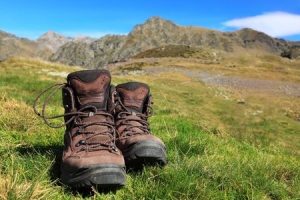
Boots
What do I wear on my feet? Well first I always wear merino wool or blended socks. I have thin ones for summer, mid weight ones for spring and autumn and thick ones for winter.
What about boots. Boots are classed in the following way: B0, B1, B2 and B3.
Your trainer would be classed as a B0. At the other end of the scale a B3 is completely stiff. The footbed, heel and ankle support are all stiff and do not move independently of each other.
A B3 boot is completely stiff. They have very deep treads, massive protection for the toes, heel and ankle. This means they are more difficult to walk in on normal conditions. Even walking on mud and an inch of snow can be uncomfortable. They are designed to give you full support on deep snow or mixed and ice climbing. When walking on deep snow you get a role effect as the boot goes from heel to toe in a normal walking pattern. With these boots you can plant your foot flat on the snow to walk, giving you full support on your arch and the back of your leg. Basically, you won’t tire out as quickly. They are heavier than other boots but a lot warmer. They come in warmth ratings but usually go from -10c to -25c. You need to wear a thick Marino wool mountaineering sock with these boots. Some people wear a liner sock as well for extra warmth.
A B2 has a stiff footbed. The heel and ankle support are also stiff or semi-stiff but move independently of each other. It makes it easier to walk, making it more familiar to a normal shoe but gives you loads of foot and ankle support. It also means when walking in challenging conditions you get extra support and protection. These boots have a tuff toe box and thick tread so you can walk on really rough terrain and not feel it. If you role your foot you are extremely unlikely to hurt your ankle due the level of support in the boot. When walking in snow you can also kick steps into the snow to help you walk. With the footbed stiff you can use the toe section to gain purchase, push yourself up and the boot acts as its own platform thus giving you stability when you need it most. The biggest plus I have found that when walking up a steep hill, whether in mud or snow, you can kick into the ground with your toe. So you can walk up facing forwards. Do this with a B0 or B1 boot and you will start to feel pressure on your calves and achilles tendon. This is because you have to work really hard to keep your toes stiff so you can get the pressure required to stand up on your foot. With the B2 the boot does this for you as it is stiff. You just kick in and step up. No pressure on the backs of your legs.
A B1 boot is like a really tuff and robust trainer. It has plenty of flex in the footbed, heel and ankle support. They have deep treads for grip. The main difference between a B0 and a B1 is the footbed. In a B1 the footbed flexes length ways /vertically along the footbed but not from side to side. If you hold the heel and toe area of the footbed you should not be able to bend the boot by rolling your hands in opposite directions. If you move your hands together the boot will flex somewhere near where the toe knuckle would sit.
A B0 boot is just a trainer. Some come with an ankle support. Most still have good treads and protection for toes and heels. However, I would not recommend for any mountain walking. They are usually used for low valley and road walking.